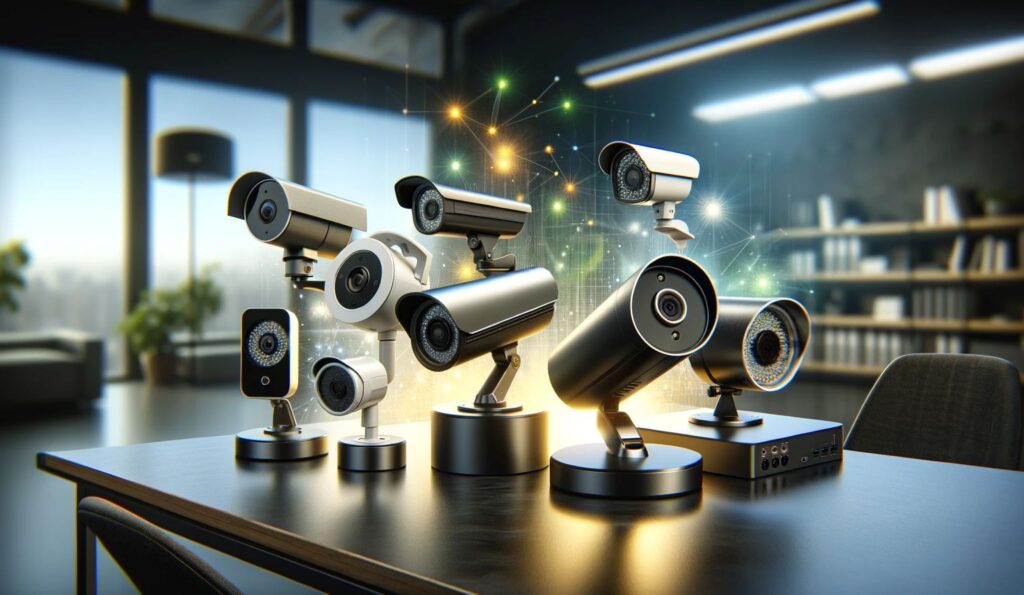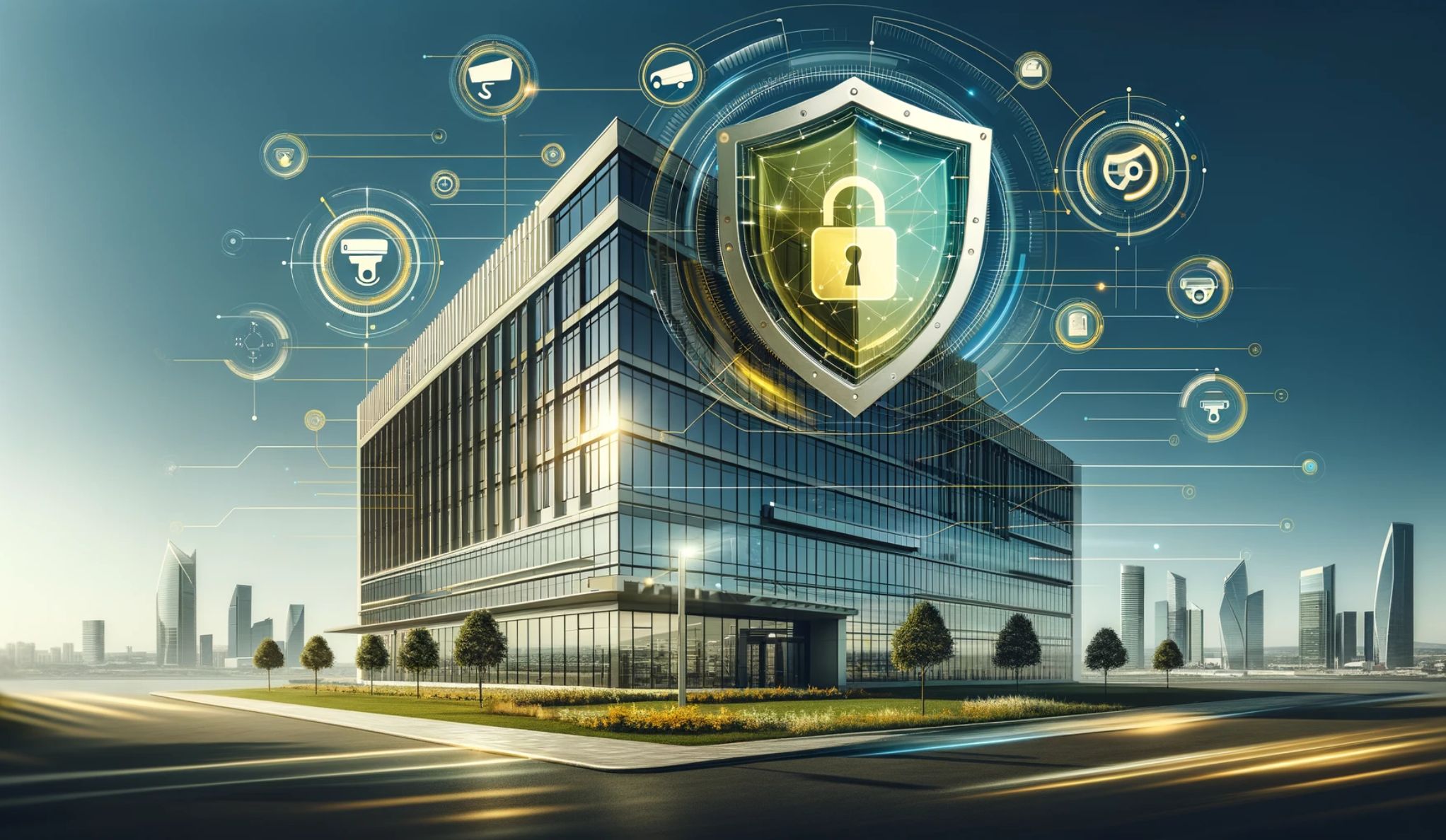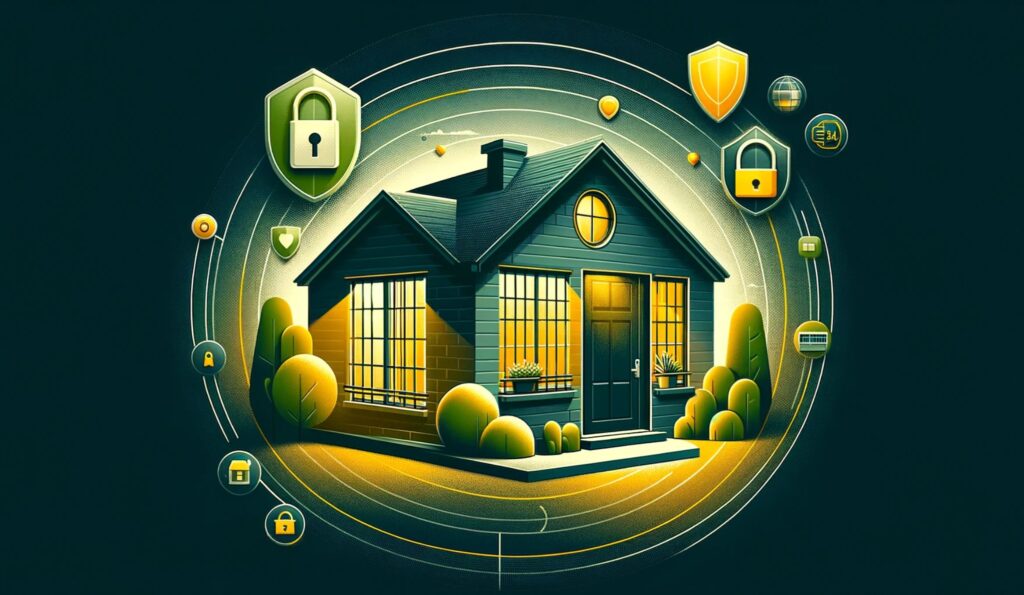In today’s fast-paced and technology-driven world, security for business is not just a precaution; it’s a necessity. Whether you run a small home office or manage a sprawling enterprise, the safety of your premises, data, and personnel is paramount. But with a myriad of threats looming – from physical break-ins to cyber attacks – understanding and implementing the right security measures can seem daunting.
This comprehensive guide is designed to simplify the complex world of business security. We recognize that every business is unique, with its own set of challenges and requirements. That’s why we aim to provide clear, straightforward solutions tailored to a wide range of business needs. From choosing the best security cameras to integrating advanced cybersecurity measures, we’ll cover all the bases to help you build a robust security strategy.
Our journey will take us through the various types of security systems suitable for businesses, offering insights into their functionalities and benefits. We’ll delve into how to select the most effective security cameras, implement comprehensive security solutions for different business sizes, and explore innovative security technologies shaping the future.
Types of Security Systems for Businesses
Securing a business involves more than just locking the doors after hours. In today’s world, where threats can come from both physical and digital realms, a comprehensive approach to security is crucial. Businesses, regardless of their size, must employ a variety of security systems to ensure complete protection. These systems range from surveillance cameras to sophisticated cybersecurity measures, each playing a vital role in safeguarding a company’s assets, data, and personnel.
Surveillance Cameras: Essentials for Business Monitoring
The first line of defense for many businesses is surveillance cameras. These cameras serve multiple purposes: they deter potential intruders, monitor ongoing activities, and provide crucial evidence in the event of a security breach. When selecting surveillance cameras, consider factors such as camera resolution, field of view, and storage options. Modern surveillance systems also offer features like remote viewing, motion detection, and night vision, enhancing their effectiveness in business security.
Intrusion Detection Systems: Frontline Security
Intrusion detection systems are critical in alerting businesses to unauthorized access or breaches. These systems can range from basic alarm setups to advanced solutions that include sensors for doors, windows, and even interior spaces. The key is to choose a system that is both responsive and reliable, ensuring that any intrusion attempts are promptly detected and addressed.
Access Control Systems: Managing Entry and Exit
Controlling who enters and exits your business premises is fundamental to maintaining security. Access control systems can range from simple keypad entry systems to advanced biometric solutions. These systems not only restrict access to unauthorized individuals but also help in tracking entry and exit times, which can be vital in investigating security incidents.
Cybersecurity Measures for Business Protection
In the digital age, cybersecurity is as important as physical security. Protecting your business online involves securing your networks, safeguarding sensitive data, and training employees on cybersecurity best practices. Implementing firewalls, using secure passwords, and regularly updating software are basic steps toward robust cybersecurity. Additionally, staying informed about the latest cyber threats and trends is crucial for ongoing protection.
Selecting the Best Security Cameras for Your Business

Choosing the right security cameras is a key step in fortifying the safety of any business. The process goes beyond simply picking a camera; it’s about finding a solution that aligns perfectly with your business’s unique requirements. With an array of options available in the market, the task can seem daunting. However, focusing on key criteria can guide businesses to make informed decisions, ensuring effective and efficient surveillance.
Criteria for Choosing the Right Cameras
Selecting the ideal security cameras involves several critical considerations:
- Resolution: High-resolution cameras capture clearer images, crucial for identifying details in security footage.
- Field of View: A wider field means more area covered, potentially reducing the total number of cameras needed.
- Lighting Conditions: For areas with low light, choose cameras with strong night vision capabilities.
- Storage Options: Decide between local storage or cloud-based solutions based on your access and space requirements.
- Durability: If installing outdoors, ensure the cameras are weatherproof to withstand environmental elements.
- Additional Features: Look for cameras with motion detection, remote access, and zoom capabilities for enhanced functionality.
Top-Rated Security Cameras for Various Business Types
The best security camera varies depending on the nature of the business:
- Retail Stores
- Cameras with wide-angle lenses for extensive coverage.
- High-resolution cameras to capture detailed images, essential for incident investigations.
- Office Environments
- A mix of indoor and outdoor cameras.
- Remote viewing capabilities for monitoring from different locations.
- Sensitive Industries (e.g., Banking, Pharmaceuticals)
- Cameras with advanced security features like motion detection.
- Tamper alerts to enhance security in critical areas.
The right security camera for your business depends on specific needs and environmental conditions. By evaluating these factors and the features of different cameras, businesses can secure their premises with an effective and tailored security solution.
Implementing Effective Security Camera Systems
The implementation of security camera systems goes beyond mere installation. It’s about creating a cohesive and integrated approach that aligns with your overall business security strategy. Effective implementation enhances the capability of your security cameras, turning them into a powerful tool that not only records incidents but also prevents them.
Integration of Cameras with Overall Security Strategy
Integrating security cameras into your overall security strategy involves several key steps:
- Assessment of Vulnerabilities: Identify the most vulnerable areas in your business premises where surveillance is crucial.
- Strategic Placement: Position cameras to maximize coverage and minimize blind spots. Consider both indoor and outdoor placements.
- Network Integration: Connect cameras to your network for remote monitoring and easy data access.
- Compliance with Regulations: Ensure that the placement and usage of cameras comply with legal requirements and privacy laws.
- Regular Maintenance: Schedule routine checks and maintenance to keep the system functioning optimally.
Case Studies: Successful Security Camera System Implementations
Real-world examples demonstrate the impact of well-implemented security camera systems:
- Retail Store Overhaul: A retail chain experienced a significant reduction in shoplifting incidents after strategically placing high-resolution cameras at entrances, exits, and point-of-sale areas. The integration of these cameras with motion sensors and alarms created an effective deterrent against theft.
- Office Building Enhancement: An office complex improved its security by installing cameras with remote access capabilities. This allowed management to monitor premises after hours, leading to a prompt response to an attempted break-in, showcasing the system’s effectiveness.
- Manufacturing Plant Update: A manufacturing plant faced challenges with inventory shrinkage. After implementing a comprehensive camera system covering warehouses and production areas, the company could trace and rectify the issues, resulting in improved inventory management.
Comprehensive Security Solutions for Different Business Sizes
Security needs vary greatly depending on the size and nature of a business. While a small home office might require basic security measures, a larger enterprise may need a more advanced, multi-layered approach. Understanding the specific security requirements of your business is crucial in implementing effective solutions. Tailoring security strategies to fit the size and complexity of your business ensures not only the protection of physical and digital assets but also provides peace of mind.
Tailoring Security for Small Businesses and Home Offices
Small businesses and home offices generally have limited resources for security, but this doesn’t mean they should compromise on safety. Key considerations for smaller setups include:
- Cost-Effective Solutions: Opt for security systems that offer essential features within a reasonable budget.
- Ease of Installation and Use: Choose systems that are easy to install and manage, possibly without needing professional help.
- Scalability: As your business grows, your security system should be able to grow with it.
- Remote Monitoring Capabilities: Systems that allow remote access through smartphones or computers are ideal for small business owners who are often on the move.
Advanced Security Strategies for Larger Enterprises
Larger enterprises face more complex security challenges and therefore require more sophisticated solutions. Key elements of an advanced security strategy for larger businesses include:
- Integrated Security Systems: Combine surveillance cameras, access control, intrusion detection, and cybersecurity measures into a cohesive system.
- Customization: Tailor security solutions to address the specific risks and challenges faced by the enterprise.
- Continuous Monitoring and Professional Management: Employ dedicated personnel or services for continuous surveillance and management of the security system.
- Regular Audits and Updates: Conduct regular security audits and update the systems as needed to counter emerging threats.
By understanding and addressing the unique security needs of different business sizes, from small home offices to large enterprises, businesses can create a secure environment that protects against both current and future threats. This tailored approach not only safeguards physical and digital assets but also fosters a safe and productive working environment.
Innovative Security Technologies for Businesses
As technology advances, so do the ways in which businesses can protect themselves. Innovative security technologies are continually emerging, offering new and improved methods for safeguarding business assets. Staying abreast of these advancements is not just beneficial; it’s essential for businesses looking to maintain robust security in a rapidly evolving digital landscape. From AI-enhanced systems to the latest trends in security technology, understanding these innovations can significantly bolster a company’s defense mechanisms.
The Role of AI and Machine Learning in Security
Artificial Intelligence (AI) and Machine Learning (ML) are revolutionizing business security. These technologies bring several enhancements to traditional security systems:
- Predictive Analysis: AI and ML can analyze patterns in data to predict and alert about potential security breaches before they happen.
- Automated Surveillance: AI-powered surveillance cameras can distinguish between routine activities and unusual events, reducing false alarms.
- Facial Recognition and Biometric Systems: Advanced identification technologies improve access control, making unauthorized access more difficult.
- Cybersecurity: In the digital domain, AI and ML algorithms are crucial in identifying and defending against sophisticated cyber threats.
Emerging Trends in Business Security Technologies
Keeping up with the latest trends is key to ensuring your business security strategy is up-to-date:
- Internet of Things (IoT) Security: As more devices get connected, securing IoT networks becomes crucial to prevent data breaches.
- Cloud-Based Security Solutions: Cloud security provides flexibility and scalability, allowing businesses to adjust their security needs as they grow.
- Mobile Security Management: With the increase in remote working, mobile security solutions are becoming essential for protecting business data on the go.
- Blockchain for Security: Blockchain technology offers a decentralized way to secure transactions and data, reducing the risk of tampering.
Innovative security technologies offer businesses a way to not only react to security threats but also to proactively anticipate and mitigate them. By integrating these advanced technologies into their security strategies, businesses can stay one step ahead in safeguarding their operations against both physical and digital threats.
Understanding and Managing Security Risks
Managing security risks effectively is crucial for any business. It involves a proactive approach where you identify potential threats and strategize to mitigate them. This process is vital for businesses of all sizes, as it helps in preventing security incidents and minimizing their impact should they occur. By addressing security risks comprehensively, businesses can safeguard their assets, uphold their reputation, and ensure the safety of employees and customers.
Identifying Common Security Threats to Businesses
The first step in effective risk management is recognizing potential security threats. Businesses today face various challenges, including physical breaches such as unauthorized entry and theft, cyber attacks like hacking and phishing, internal threats from employees, data breaches, and even natural disasters. Understanding these threats is crucial in tailoring security measures to address specific vulnerabilities.
Best Practices for Risk Assessment and Management
Effective risk management involves several key practices. Regular risk assessments are essential for identifying potential vulnerabilities. Training employees on security protocols and the importance of reporting suspicious activities is another critical step. It is also important to develop clear security policies and invest in quality security systems. Protecting data through strong passwords, encryption, and regular backups is vital. Additionally, having an emergency response plan is crucial for quick and effective action in case of security incidents.
Enhancing Security Through Employee Training and Policies
A robust security strategy extends beyond technological solutions; it encompasses the human element of your business – your employees. Investing in employee training and developing effective security policies are essential steps in creating a comprehensive security framework. By empowering employees with knowledge and clear guidelines, businesses can significantly enhance their overall security posture.
Importance of Staff Training in Security Protocols
Staff training plays a crucial role in strengthening a company’s security. Employees need to understand the various security risks and the role they play in mitigating them. Training should cover topics like how to handle sensitive information, recognize potential security threats, and respond to security incidents. Regular training sessions ensure that all employees are updated on the latest security protocols and understand their responsibilities in maintaining a secure business environment.
Developing Effective Security Policies and Procedures
The development of clear and effective security policies and procedures is another critical component. These policies should outline the expected behaviors and actions of employees in various scenarios, from managing passwords to responding to a data breach. Policies need to be easily accessible and understandable, ensuring that all employees, regardless of their role or level, can comprehend and adhere to them. Regularly reviewing and updating these policies ensures they remain relevant and effective in the face of evolving security challenges.
The Future of Business Security: Predictions and Preparations
In a world where technological advancements and security threats evolve rapidly, staying ahead in business security is not just about addressing current challenges, but also about anticipating future risks. Understanding the potential future landscape of business security can guide companies in making informed decisions and investments, ensuring long-term protection and resilience.
Anticipating Future Security Challenges
The future of business security is likely to be shaped by several key factors:
- Advancing Cyber Threats: As technology advances, so do the methods used by cybercriminals. Businesses must stay vigilant about emerging cyber threats such as more sophisticated malware and phishing attacks.
- Integration of AI and Automation: These technologies will play a bigger role in security, offering both opportunities for enhanced protection and new vulnerabilities to guard against.
- Increased Data Privacy Concerns: With more data being collected and stored, businesses will face greater challenges in managing data privacy and complying with evolving regulations.
- Physical Security in a Digital World: The line between physical and digital security will continue to blur, requiring integrated approaches for comprehensive protection.
Preparing Your Business for Evolving Security Needs
To stay prepared for these evolving security needs, businesses should consider the following steps:
- Invest in Ongoing Education: Regular training and updates for staff on the latest security trends and threats.
- Stay Updated with Technology: Regularly update and upgrade security systems to leverage the latest in security technology.
- Develop Agile Security Strategies: Create flexible security strategies that can adapt to changing threats and business needs.
- Collaborate and Share Information: Engage with industry peers and security experts to share knowledge and stay informed about emerging risks.
As we look to the future, businesses that proactively adapt their security strategies to meet evolving challenges will be best positioned to protect their assets, data, and people. Being forward-thinking and adaptable in security planning is not just a measure of protection; it’s a strategic advantage in a world where security is increasingly complex and critical.
Conclusion
In this comprehensive exploration of business security, we’ve navigated through the essentials of various security systems, the significance of tailoring security strategies to different business sizes, and the impact of innovative technologies. We’ve underscored the importance of employee training and robust policies, and looked ahead to the future challenges and strategies in business security. Ultimately, this guide emphasizes that effective business security is a dynamic and ongoing process, combining advanced technology with human insight. By staying informed, adaptable, and proactive, businesses can not only safeguard their assets but also foster a secure, productive environment for their growth and success.








